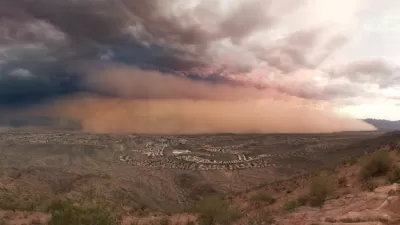In the developed world, increased urbanization can be a net boon for the environment. Yet, writes Bryan Walsh, if not planned for carefully, the rapid urbanization of developing world could have a dramatic impact on climate change and biodiversity.
Walsh summarizes the findings, and recommendations, of a new paper published in the Proceedings of the National Academy of Sciences that outlines the dramatic increase in urban populations and urban land expected globally by 2030, and the potential impact on climate change and biodiversity. In the developed world, increased urbanization can bring environmental benefits such as reduced commutes and reduced household energy use.
However, urbanization in the developing world brings its own set of environmental challenges. As Walsh notes, "in developing nations, the move from
rural areas to cities often leads to an accompanying increase in income -
and that increase in income leads to an increase in the consumption of
food and energy, which in turns produces an uptick in carbon emissions."
Furthermore, as the PNAS paper illustrates, "[t]hose areas of Asia, Africa and parts of South America that will see
urban territory grow most rapidly tend to overlap with biodiversity
hotspots, concentrations of exotic plants and animals. Humans are the ultimate invasive species - when they move into new territory, they often displace the wildlife that was already living there...And as land
is cleared for those new cities - especially in the densely forested
tropics - carbon will be released into the atmosphere as well."
"If we do it the right way, we can mitigate urbanization's impacts on the
environment," concludes Walsh, echoing the findings reported by Karen Seto, a professor of the urban environment at Yale and the lead author of the PNAS paper.
"There is an enormous opportunity here, and a lot of
pressure and responsibility to think about how we urbanize," says Seto. "The one thing that's clear is that we can't build cities the way we
have over the last couple of hundred years. The scale of this transition
won't allow that."
FULL STORY: Urban Planet: How Growing Cities Will Wreck the Environment Unless We Build Them Right

Planetizen Federal Action Tracker
A weekly monitor of how Trump’s orders and actions are impacting planners and planning in America.

Map: Where Senate Republicans Want to Sell Your Public Lands
For public land advocates, the Senate Republicans’ proposal to sell millions of acres of public land in the West is “the biggest fight of their careers.”

Restaurant Patios Were a Pandemic Win — Why Were They so Hard to Keep?
Social distancing requirements and changes in travel patterns prompted cities to pilot new uses for street and sidewalk space. Then it got complicated.

Platform Pilsner: Vancouver Transit Agency Releases... a Beer?
TransLink will receive a portion of every sale of the four-pack.

Toronto Weighs Cheaper Transit, Parking Hikes for Major Events
Special event rates would take effect during large festivals, sports games and concerts to ‘discourage driving, manage congestion and free up space for transit.”

Berlin to Consider Car-Free Zone Larger Than Manhattan
The area bound by the 22-mile Ringbahn would still allow 12 uses of a private automobile per year per person, and several other exemptions.
Urban Design for Planners 1: Software Tools
This six-course series explores essential urban design concepts using open source software and equips planners with the tools they need to participate fully in the urban design process.
Planning for Universal Design
Learn the tools for implementing Universal Design in planning regulations.
Heyer Gruel & Associates PA
JM Goldson LLC
Custer County Colorado
City of Camden Redevelopment Agency
City of Astoria
Transportation Research & Education Center (TREC) at Portland State University
Camden Redevelopment Agency
City of Claremont
Municipality of Princeton (NJ)



























